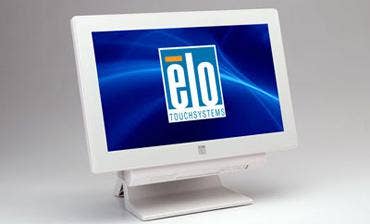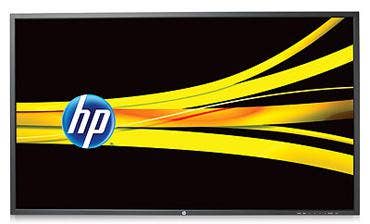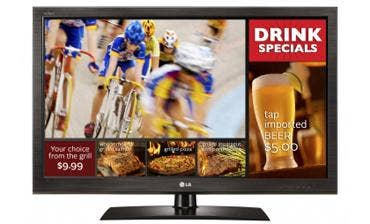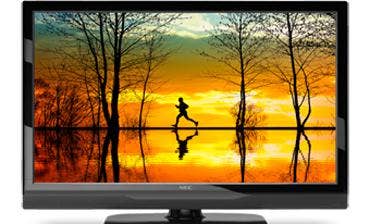Digital Signage Splash: Test Center Reviews Four Displays
The mass production of LCD displays has turned them into a commodity. A 19-inch LCD monitor that in 1998 sold for upward of $2,995 can now be had for $79.95. So it’s natural to see them appearing everywhere from the backseats of taxicabs to the picture frames in grandma’s living room.
And why not? A moving sign attracts far more eyeballs than a static poster ever could, and technologies exist that can tailor the sign’s content to the viewer in realtime. LCD screens deliver news, safety warnings, product information, restaurant menus and train and airline flight information. They also can be used to make reservations, sell tickets, or even be the front end of digital jukebox.
What’s more, they’re increasingly being used as decoration. In the passageway between two of its terminals at JFK Airport, American Airlines treats passengers to beautiful and moving images of international landscapes. And in department stores, it’s becoming more common to be helped by a ’point of information’ kiosk that can provide just-in-time data or discounts to spur a purchase. UNIQLO, a Japanese clothing retailer with three stores in New York City, recently reached an agreement with a solution provider for more than 400 NEC Display Solutions of America screens to promote its products to shoppers in its flagship UNIQLO New York Fifth Avenue store and other locations.
In addition to the market for lobby signs and decorative signage applications, which are typically one-off sales with periodic content updates, there are a few signage applications with the potential to generate regular streams of recurring revenue.
The first, and perhaps easiest to sell, is for in-store promotion of a customer’s own products or services. These are increasingly popping up in menus at quick-serve restaurants and delis but also can be seen in stand-alone ceiling or counter signs that display ’Today’s Specials.’
The infrastructure for these products requires either a PC to drive content to each display, or a product that can display content from a USB stick. Solution providers generate recurring revenue from managing and updating content.
The second, and a bit more challenging, is the sale of signage for hyperlocal marketing. Imagine one customer that a solution provider already services is a deli. That deli might share space in a strip mall with a dry cleaner, a pet store, a restaurant and a bank. A solution provider might approach the deli owner to buy a digital sign to use as a menu display and offer to split the revenue that the dry cleaner is paying to advertise in a small box on the deli menu.
The dry cleaner might in turn purchase its own sign and run reciprocal ads from the deli, which might promote its breakfast and lunch specials at certain times of day. These two customers pay nothing to each other, but each generates revenue for the solution provider for managing the content and sending monthly reports.
A third way, and the most potentially lucrative one, is for a solution provider’s digital signs to be offered as part of a digital signage network. According to Pierre Richer, president and COO of NEC Display Solutions, this market also is the most complicated, and solution providers looking to enter it should have a solid background in advertising.
’It’s a bit like selling television, radio and print, but a lot more complex,’ he said, because of all the technologies and players involved.
The Test Center put four products to the test for this digital signage feature. Products tested include Elo TouchSystems’ 22C2 Medical All-in-One Touchcomputer, Hewlett-Packard’s LD 4720 Digital Signage Display, LG’s 42LV355B EzSign TV and Software and NEC’s E462 46-inch Entry-Level Commercial Display. Rather than conducting a head-to-head review, the Test Center evaluated each product for its ability to meet its intended purpose.
To test image quality, we displayed the LCD monitor calibration and testing images found at www.lagom.nl/lcd-test. We looked most carefully at the contrast, color gradation, white saturation and black level capabilities of each display.
NEXT: Elo TouchSystems 22C2 Medical All-In-One Touchcomputer
Elo TouchSystems 22C2 Medical All-In-One Touchcomputer

Solution providers targeting the health-care industry are surely familiar with the requirements that devices must adhere to before they’re acceptable for use in hospitals and other facilities dealing with human lives. Elo TouchSystems, a division of TE Connectivity that develops and markets touch-sensitive displays and systems, in August added 19- and 22-inch models to its C-Series Medical All-in-One Touchcomputers with certifications for use in health care.
Both new models are certified under the UL60601-1 and IEC60601-1 specifications for electrical safety and comply with the EN 60601-1 specification for safety and EN55022, EN55024, and EN 60601-1-2 for electromagnetic compatibility. What’s more, both are RoHS (restriction of hazardous substances) compliant and are enclosed by a PI-X1-certified cabinet that’s resistant to dripping water and spills.
We found the 22C2 to be a rugged and responsive workstation that’s as handsome as it is durable. The 22-inch display is bright and crisp and worked perfectly with touch navigation once the correct drivers were installed. The test system was equipped with a dual-core 32-bit Atom 1.66GHz processor running Windows 7 Professional on 2-GB DDR2 memory (expandable to 4 GB) and Intel GMA 3150 graphics. It’s also available with Windows POSReady 2009 or with no operating system.
Out of the box, the display performed best on the contrast and black level test screens. For contrast, all but two of the 32 color regions were discernable, and in black level tests, 10 of the 12 boxes were visible. For white saturation, only four of the 12 checkerboards were clearly visible. Lowering the contrast setting brought more checkerboards into view. On-screen controls, which consist of menu, select, and left and right arrows, are found along the bottom edge of the display.
The Atom-based LED-lit unit requires no fan and consumed just 46 watts under normal load and never exceeded 96 degrees. The screen at its hottest point measured 91 degrees. All C-Series models support single-finger gestures on Windows 7; a multitouch screen is optional.
The system is equipped with six USB 2.0 ports, Gigabit Ethernet, two RS-232 ports, audio in/out, and two PCI-E expansion slots. Elo-branded PCI-E expansion options include Wi-Fi, dual USB/cash drawer port, RAID, second VGA port and others.
Elo TouchSystems also offers multiple options in terms of touch technologies, including resistive and capacitive products that are responsive to nonorganic materials such as a gloved hand. The two models are available only in white, which the company says is preferred by health-care environments for its aesthetics.
Depending on configuration, the Elo TouchSystems 22C2 Medical All-in-One Touchcomputer list price ranges between $1,600 and $2,300 and is backed by a three-year warranty with advance replacement in North America.
NEXT: Hewlett-Packard LD4720 Digital Signage Display
Hewlett-Packard LD4720 Digital Signage Display

Hewlett-Packard introduced 42- and 47-inch digital signage products in September, both of which feature multitouch displays and second-generation Intel-based content players as options. The company sent the 47-inch LD4720 to our lab for review, and testers were mostly impressed with what they found.
The first thing that set the HP display apart was its sturdy steel cabinet. The LD4720 is built to operate 24x7 and doing so will stay within the confines of HP’s three-year warranty. HP further distinguishes itself by including three cables, one for each of its DisplayPort, HDMI and VGA ports.
Also present is an Ethernet port, through which the included Sign Manager software controls the monitor’s settings, keeps tabs on its health and can schedule its hours of operation (also possible through an RS-232 port). To get the Sign Manager software to work properly on our 64-bit Windows testbed, it had to be set to execute in compatibility mode for Window XP SP3.
Sign Manager can be used to control most of the monitor settings accessible through the unit’s on-screen display, including the setup of tile mode, input, A/V quality, backlight brightness and so on. In addition, the software can be used to set up alerts, add security to limit access, perform software upgrades and send text messages to any or all screens on a network. This useful tool can be used to control a single monitor at a time or any number of units in a group. Input ports also can be labeled, but only through the OSD. The LD4720 also includes a built-in media player. Upon insertion of a memory stick on the unit’s single USB port and entering a four-digit password, the LD4720 browses the files and feeds them to the player, which supports MP3 and AC3 audio files and MPEG, Xvid and AVI video files. For sound, HP offers a 10-watt speaker kit (connected via bare-wire speaker outputs); the LD4720 lacks built-in speakers.
HP’s digital signage display stands 42.5 inches wide by 28 inches high with the optional table stand, which consists of two separate legs, each fastened with two screws. Once in place, the table stand does not allow the screen to tilt or swivel. Rubber feet under each leg keep the monitor firmly in place, but any attempt to swivel the monitor causes the legs to twist slightly as the steel uprights cause each leg’s plastic base to spread. The legs lack holes for bolting the display into place (a trait common to all four monitors in this article).
Display characteristics were excellent. Using factory default settings, the contrast test displayed all 32 color levels distinctly; all black levels were visible and all but two white saturation patterns were discernible. Heat dissipation was another matter. After about an hour of operation, the screen temperature was measured at a rather warm 105 degrees at its hottest, and between 101 and 103 degrees elsewhere. The vent at the top of the unit’s back side peaked at 134 degrees, and measured about 114 degrees everywhere else. The LD4720 consumed between 230 and 247 watts during tests. The screen brightness is rated at 700 nits.
Weighing in at 57 pounds, it would have been beneficial to have carrying handles included -- which is a small but welcome feature for installers. Also, when using the table stand, which lifts the unit less than 3 inches off the tabletop, testers found it difficult to plug cables into the down-facing port panel, which is visible only from underneath. This panel is most easily accessed when the unit is installed overhead.
HP was unable to provide us with its PC module -- the Signage Player mp8200 -- in time for this review, so we’re unable to report on the company’s whole solution. But with the features and software of the LD4720, and its 42-inch counterpart, HP has a solid offering for the digital signage market. The company was set to begin shipping the new units in October; pricing was not immediately available.
NEXT: LG 42LV355B EzSign TV And Software
LG 42LV355B EzSign TV And Software

For the digital signage market, the best thing about LG’s 42LV355B EzSign television isn’t its large size or the number of pixels it displays. And it isn’t the unit’s eight inputs or the fact that EzSign TVs are available in 32-, 42-, 47- and 55-inch models. It’s not even the bright picture and efficient power consumption afforded by the LED backlight of our test unit.
While the CRN Test Center considers those characteristics to be good or even great, the best thing about LG’s digital EzSign TV is the EzSign digital signage software that comes with it. This Windows app is so simple to use it took only 10 minutes for us to install the software, create a digital sign and display it on the EzSign monitor. And here’s the best part: It doesn’t require a PC to display signage content -- everything is handled by the monitor.
Here’s how it works:
Once the Adobe Air-based EzSign is installed and launched, it presents four simple steps for creating signage.
Step one is to select a template from a list of 33 predeveloped templates included with the tool. All but eight of the layouts are built around TV windows of various sizes.
Step two is to select images that will be wrapped around the TV window. The software accepts any combination of files in BMP, GIF, JPG and PNG formats and allows for some cropping. Files are automatically converted for display in the layout; display order and transition speed can be altered here with ease.
Step three is to input the text that will accompany the images from step two. A deli, for example, might display the names and prices of today’s special sandwiches. If the layout has a crawl, the text is entered here as well. Font size, alignment, color and other characteristics also are adjusted here to coincide with user preferences and fit. A preview button is available at every step and presents the layout as it will appear at each stage of development. Dummy content is displayed in the TV window in preview mode.
The final step is to preview the finished product and export it to a USB stick. When a USB stick is inserted into the monitor’s USB slot, an interface pops up with a choice to display EzSign content or lists of movies, photos or music. A media player built into the monitor supports all major formats, including AVI, FLV, MPG, WMV movies and MP3 audio files. While bass response is limited, sound quality is otherwise excellent with no distortion. Playback is controlled by dedicated buttons on the remote, which also are used to navigate to the saved signage content. Media can be played only from the USB device; signage can be played from the stick or copied to the TV and played.
LG’s EzSign cannot be updated remotely, however, so it’s suitable for signage networks only if accompanied by a PC. Also, the signage (Adobe Air-based) software is a bit rough around the edges, with bits of broken English and an unintuitive user interface in places. Still, the versatile unit performed well in all three LCD tests. It offers a total of eight inputs: two HDMI, two A/V, component, VGA, cable television (for digital/analog tuner) and USB, each of which can be custom-labeled in the on-screen display using predefined values. The 42LV355B ran cool, at about room temperature, and consumed just 47 watts without the tuner, and 95 watts with.
LG’s 42LV355B with EzSign software is a solid value for solution providers seeking a signage solution that can be locally maintained and used for hyperlocal marketing or to promote in-store specials. The 42-inch unit lists for $1,599, and a 55-inch version lists for $2,899. Both of the LG units include a two-year warranty.
NEXT: NEC E462 46-Inch Entry-Level Commercial Display With Tuner
NEC E462 46-Inch Entry-Level Commercial Display With Tuner

With displays ranging from horizontal bar-type screens you might see on subway trains, to gigantic LED displays found in many stadiums, NEC Display Solutions of America offers perhaps the broadest array of digital signage products in the industry, with five signage lines as well as Vukunet, a top-notch content management system, at no extra charge.
For Test Center review, the company submitted the E462, a 46-inch 1,080p model from its E-Series of entry-level commercial- grade television monitors, which also includes 32- and 42-inch models. This year NEC enhanced its E-Series models with an RS-232 port for remote control, synchronizing settings on multiple monitors and disabling local controls. The E-Series now also employs a Basic Digital Information Display (B-DID) panel, which allowed the company to extend its warranty to three years from two.
Like all E-Series models, this large, no-nonsense display is intended for boardrooms, corporate lobbies, educational institutions, health clubs, retail stores, sports bars, waiting rooms and any application that calls for a bright, crisp display that can be controlled remotely using a PC.
It includes an analog/digital tuner, built-in stereo speakers, a media player for MP3 and JPG formats, VGA cable, full-function wireless remote, standard power cord and a table stand. Options include a VESA wall mount and an external dual-core 1.6GHz single board computer.
Setting up the unit was straightforward. With the stand in place and the unit plugged in, the NEC monitor winked to life at the touch of its power button. The control panel is located on the lower right-side edge and includes volume, channel, menu and input controls. Its eight inputs include TV, composite, component, VGA, three (3) HDMI and USB. A left-side panel provides single HDMI, composite and USB inputs plus a headphone jack; the remainder of the input ports are mounted on the rear panel, which also is home to the RS-232 port and an optical digital audio output port.
Out of the box, the E462 passed the contrast test with flying colors. All 32 levels of brightness were visible using the monitor’s default brightness, contrast and saturation settings. Some improvement was possible in terms of black level; black boxes were visible starting with number three. White level had five of the 12 boxes indistinguishable from the background. On the other hand, the E462’s performance in the gradient test was outstanding, with almost no banding visible across shades of gray.
As with most monitors that employ fluorescent backlighting, the E462 runs a bit warm. At its hottest point, the top right side of the exhaust vent measured 103 degrees after several hours of operation. The screen itself measured 101 degrees at its hottest point in the upper right corner. Solution providers should keep in mind that this unit will warm up a room if it’s not adequately ventilated. The E462 drew 158 watts in tests without the tuner. In standby mode, the unit drew less than 1 watt, according to our instruments.
The E462 measures 44.4 inches wide by 32.4 inches high with the stand, 27.6 inches without. For solution providers seeking a bright, versatile display with a wide array of inputs and options, the E462 from NEC Display Solutions is a fine solution. It lists for $899 and is covered by a three-year warranty on parts and labor, including the backlight.
The Future Is Bright
There’s a largely untapped market of digital signs out there that’s as vast as a solution provider’s imagination. With a little creative thinking, even a conservative estimate would put 50 percent of a solution provider’s existing customers in the category of being able to benefit from digital signage marketing of some kind.
Whether used to promote their own products, services and specials, provide information at the point of interest, generate revenue by helping neighbor companies, or setting up a full-blown ad network, all that’s left is for solution providers to dream up the means and select the right products to offer.